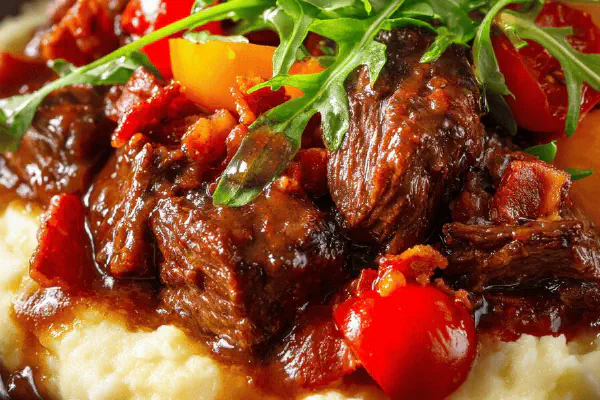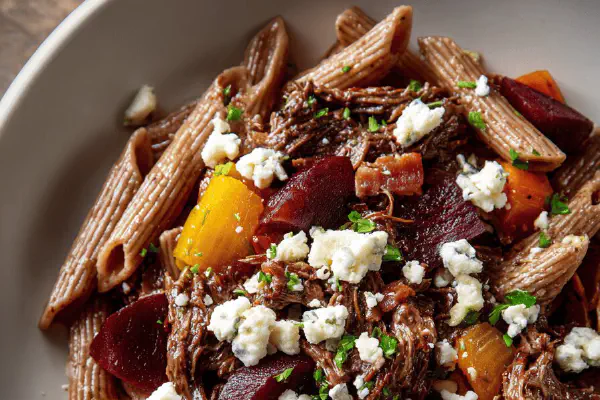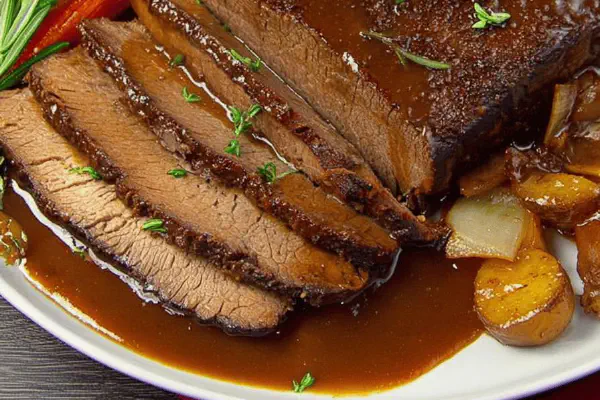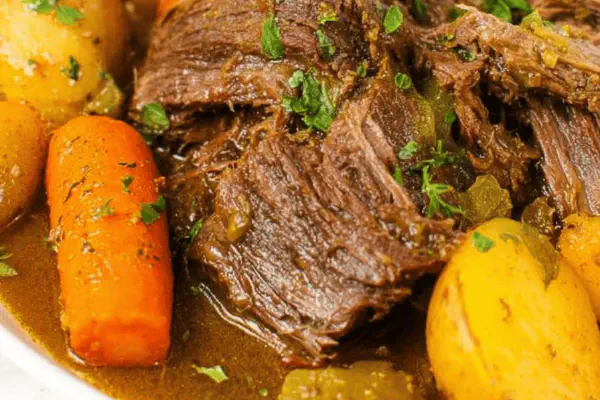Braised Beef Pappardelle Twist
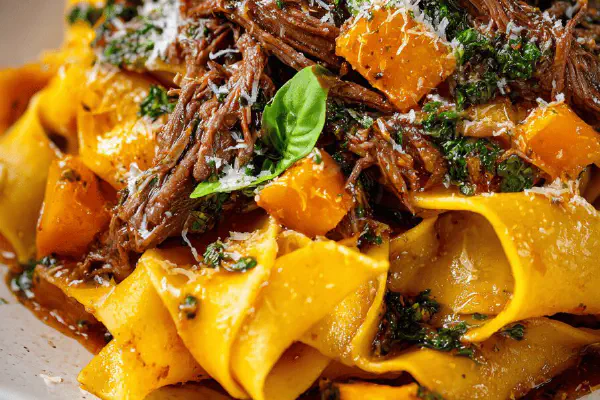
By Emma
Certified Culinary Professional
Ingredients
- 500 g brisket of beef, boneless, cut into medium chunks
- 25 ml vegetable oil
- 1 whole onion diced
- 1 large carrot diced
- 1 celery stalk diced
- 4 cloves garlic, whole roasted and smashed
- 25 ml tomato paste
- 200 ml Madeira wine
- 300 ml beef stock
- 40 g freshly grated pecorino romano cheese
- 15 g chopped fresh basil leaves
- Zest of 1 lemon
- 400 g diced butternut squash, smaller dice
- 350 g pappardelle pasta
About the ingredients
Method
- Preheat oven 175°C. Position oven rack midway.
- Heat oil in heavy oven-safe pot medium-high. Brown beef pieces in batches, avoid crowding; turn when deep mahogany all over. Salt and pepper each batch. Remove beef to plate.
- Reduce heat to medium, toss in diced onion, carrot, celery. Sauté 3-4 minutes until glossy and fragrant, softened but not browned sharply.
- Add roasted garlic cloves—aromatic, mellow sweetness—stir with vegetables 1 minute. Stir in tomato paste; cook off raw edge 90 seconds. Watch paste deepen slightly, no burning.
- Splash Madeira; clamp down with wooden spoon scraping fond. Reduce liquid by two-thirds, watching bubbling slow to syrupy consistency.
- Return beef to pot. Pour beef stock. Should barely cover meat. Bring up to rapid simmer; cover tightly with lid or foil.
- Transfer pot to oven. Braise 2 hours 15 minutes. Check halfway: meat should start to pull apart tender. If liquid reduces too much, add a bit hot stock or water.
- Remove from oven. Using two forks, shred beef directly in pot, mashing gently to release juices, sauce thick and glossy.
- Meanwhile, steam diced butternut squash 4 minutes till just tender. Avoid mushy squash; it adds sweet texture but should hold shape.
- Cook pappardelle in large salted water till al dente, test often. Reserve 250 ml pasta water before draining.
- Add drained squash and pasta to beef. Pour 125 ml pasta water, sprinkle half pecorino and basil, lemon zest. Toss vigorously over low heat, one minute, coating pasta, lifting sauce.
- Adjust texture with more pasta water if dry or sticky. Final seasoning check: salt, pepper, citrus brightness.
- Serve topped with remaining cheese and basil. Serve promptly; pasta will absorb sauce quickly.
Cooking tips
Chef's notes
- 💡 Brown brisket chunks dry in batches. Crowding traps steam, stops caramelization. Look for deep mahogany color all around. Smells nutty, faint smoke, signals right Maillard. Salt and pepper as you go, seasoning layers build here.
- 💡 Roast garlic wrapped in foil at moderate heat till soft, caramel aroma develops. Adds mellow sweetness impossible from raw garlic. Smashed cloves in sauce melt, blend with tomato paste. Avoid substitutes with raw minced garlic straight in; bitterness, harshness appear.
- 💡 Reduce Madeira wine until syrupy but not burnt. Watch bubbles slow to thick consistency. Leftover alcohol smells will show if overcooked. Sticky syrup coats spoon, rich scent piques senses. If no Madeira, fortified sherry or port work, add same sweet nuttiness.
- 💡 Steam butternut squash just until tender. Avoid mushy. Crisp edges hold shape, contrast richness of beef. Smaller dice so each bite balanced. Overcooked squash breaks, water dilutes sauce. Timing matters; test with fork, slight resistance okay.
- 💡 Toss pasta with reserved starchy water, cheese, herbs, lemon zest off heat. Avoid dry or sticky texture by adding water bit by bit. Quick vigorous toss activates cheese melt and sauce cling. Basil adds fresh lift, lemon zest brightens heavy sauce. Timing here crucial.
Common questions
Can chuck roast replace brisket?
Yes but dry risks higher. Chuck less fatty, breaks down fast. Need tighter watch on moisture. More frequent stirring, add stock if drying. Texture differs — chuck shredded can be stringier.
What if no Madeira wine?
Use fortified sherry, port. Both add sweet note, less acidity than red wine. Avoid dry reds here, harsh flavors pop. If none, a splash of balsamic vinegar and sugar mix can mimic some sweetness but not same depth.
Beef fibers tough after cooking?
Braise longer low heat. Check oven temp stability. Cut into chunks evenly sized so cook uniformly. Fork test—meat should pull apart easily. If too firm, liquid might be low or temperature too hot, drying outside faster.
How to store leftovers?
Cool quickly, fridge in airtight container. Reheat gently on low heat adding splash of stock or pasta water to regain sauce texture. Freezing okay, but texture changes in squash—empties water. Best eaten within 3 days refrigerated.
